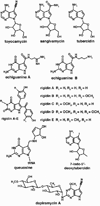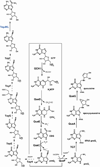Radical SAM enzymes involved in the biosynthesis of purine-based natural products
- PMID: 22902275
- PMCID: PMC4022190
- DOI: 10.1016/j.bbapap.2012.07.014
Radical SAM enzymes involved in the biosynthesis of purine-based natural products
Abstract
The radical S-adenosyl-l-methionine (SAM) superfamily is a widely distributed group of iron-sulfur containing proteins that exploit the reactivity of the high energy intermediate, 5'-deoxyadenosyl radical, which is produced by the reductive cleavage of SAM, to carry-out complex radical-mediated transformations. The reactions catalyzed by radical SAM enzymes range from simple group migrations to complex reactions in protein and RNA modification. This review will highlight three radical SAM enzymes that catalyze reactions involving modified guanosines in the biosynthesis pathways of the hypermodified tRNA base wybutosine; secondary metabolites of 7-deazapurine structure, including the hypermodified tRNA base queuosine; and the redox cofactor F(420). This article is part of a Special Issue entitled: Radical SAM enzymes and Radical Enzymology.
Copyright © 2012 Elsevier B.V. All rights reserved.
Figures










Similar articles
-
Radical SAM enzymes in the biosynthesis of sugar-containing natural products.Biochim Biophys Acta. 2012 Nov;1824(11):1231-44. doi: 10.1016/j.bbapap.2011.11.006. Epub 2011 Dec 7. Biochim Biophys Acta. 2012. PMID: 22172915 Free PMC article. Review.
-
Identification and function of auxiliary iron-sulfur clusters in radical SAM enzymes.Biochim Biophys Acta. 2012 Nov;1824(11):1196-212. doi: 10.1016/j.bbapap.2012.07.009. Epub 2012 Jul 28. Biochim Biophys Acta. 2012. PMID: 22846545 Review.
-
Auxiliary iron-sulfur cofactors in radical SAM enzymes.Biochim Biophys Acta. 2015 Jun;1853(6):1316-34. doi: 10.1016/j.bbamcr.2015.01.002. Epub 2015 Jan 15. Biochim Biophys Acta. 2015. PMID: 25597998 Review.
-
7-Carboxy-7-deazaguanine Synthase: A Radical S-Adenosyl-l-methionine Enzyme with Polar Tendencies.J Am Chem Soc. 2017 Feb 8;139(5):1912-1920. doi: 10.1021/jacs.6b11381. Epub 2017 Jan 25. J Am Chem Soc. 2017. PMID: 28045519 Free PMC article.
-
Radical AdoMet enzymes in complex metal cluster biosynthesis.Biochim Biophys Acta. 2012 Nov;1824(11):1254-63. doi: 10.1016/j.bbapap.2012.01.002. Epub 2012 Jan 14. Biochim Biophys Acta. 2012. PMID: 22269887 Review.
Cited by
-
Catalytic Promiscuity of the Radical S-adenosyl-L-methionine Enzyme NosL.Front Chem. 2016 Jun 22;4:27. doi: 10.3389/fchem.2016.00027. eCollection 2016. Front Chem. 2016. PMID: 27446906 Free PMC article. Review.
-
Antimicrobial peptides trigger a division block in Escherichia coli through stimulation of a signalling system.Nat Commun. 2016 Jul 29;7:12340. doi: 10.1038/ncomms12340. Nat Commun. 2016. PMID: 27471053 Free PMC article.
-
Changing Fates of the Substrate Radicals Generated in the Active Sites of the B12-Dependent Radical SAM Enzymes OxsB and AlsB.J Am Chem Soc. 2023 Feb 15;145(6):3656-3664. doi: 10.1021/jacs.2c12953. Epub 2023 Jan 31. J Am Chem Soc. 2023. PMID: 36719327 Free PMC article.
-
If It Is Hard, It Is Worth Doing: Engineering Radical Enzymes from Anaerobes.Biochemistry. 2023 Jan 17;62(2):241-252. doi: 10.1021/acs.biochem.2c00376. Epub 2022 Sep 19. Biochemistry. 2023. PMID: 36121716 Free PMC article. Review.
-
Comparative Genome Analysis of a Pathogenic Erysipelothrix rhusiopathiae Isolate WH13013 from Pig Reveals Potential Genes Involve in Bacterial Adaptions and Pathogenesis.Vet Sci. 2020 Jun 4;7(2):74. doi: 10.3390/vetsci7020074. Vet Sci. 2020. PMID: 32512708 Free PMC article.
References
-
- Sofia H, Chen G, Hetzler B, Reyes-Spindola J, Miller N. Radical SAM, a novel protein superfamily linking unresolved steps in familiar biosynthetic pathways with radical mechanisms: functional characterization using new analysis and information visualization methods. Nucleic Acids Res. 2001;29:1097–1106. - PMC - PubMed
-
- Walsby CJ, Ortillo D, Broderick WE, Broderick JB, Hoffman BM. An Anchoring Role for FeS Clusters: Chelation of the Amino Acid Moiety of S-Adenosylmethionine to the Unique Iron Site of the [4Fe-4S]. Cluster of Pyruvate Formate-Lyase Activating Enzyme. J Am Chem Soc. 2002;124:11270–11271. - PubMed
-
- Walsby CJ, Ortillo D, Yang J, Nnyepi MR, Broderick WE, Hoffman BM, et al. Spectroscopic Approaches to Elucidating Novel Iron-Sulfur Chemistry in the ”Radical-SAM” Protein Superfamily. Inorg. Chem. 2005;44:727–741. - PubMed
Publication types
MeSH terms
Substances
Grants and funding
LinkOut - more resources
Full Text Sources

